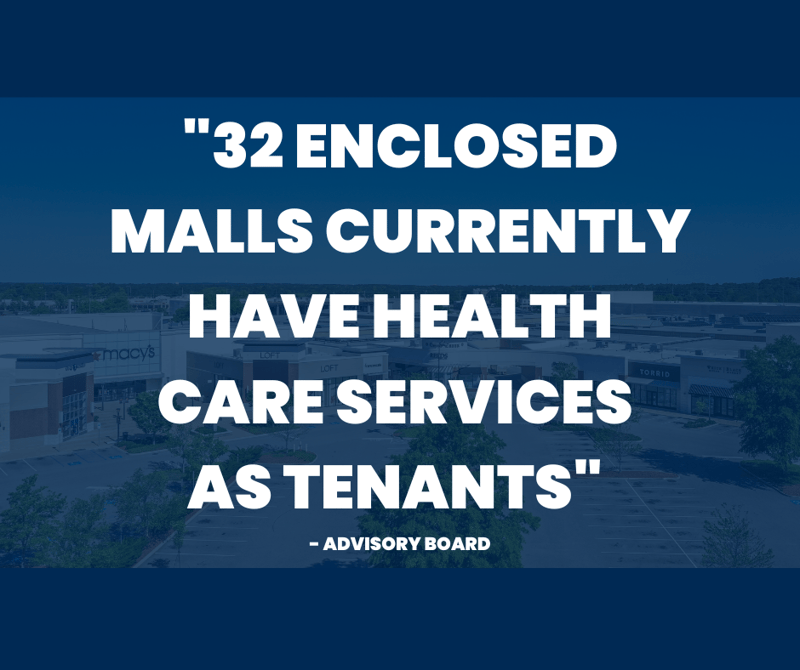Share this
by Laura Richards on October 20, 2022
“Physical malls and shopping centers seem to be a dying breed. Except where they aren’t.”
This compelling snippet from Fast Company about the stereotypes of the modern mall - and the exceptions to those stereotypes – makes you think, what’s working for retail tenants in a modern mall?
For five decades, malls were the epicenters of their communities. For shopping, socializing and entertainment, malls were it. But when the internet and online shopping became the norm, malls had a swift fall in popularity. In 2020, COVID-19 dealt a devastating blow to the already struggling facilities.
The modern mall is taking a novel approach. By integrating different tenant types and paying special attention to consumer needs, the modern mall is finding its footing in a new way.
1. Interactive Stores Are a Big Draw
Tamara Szames is an industry advisor with trend forecaster The NPD group who feel strongly about “shoptainment.” Szames predicts that shoppers, younger generations especially, are ready to come back to shopping as a form of entertainment. This is credited mostly to the urge to socialize and be unrestricted after lonely pandemic shutdowns.
The concept of shoptainment goes further than tempting window displays. It includes activity-based retailers in a mall environment. Build-A-Bear, Legoland, in-mall museums, workout facilities, co-working spaces, elevated dining experiences, car shopping options, and well-designed photo destinations are proving to be successful ways to reinforce your local mall as the place to be.
2. Medical Facilities Bring New Purpose to Old Spaces
On the other side of the pandemic coin, demand for COVID-19 testing brought a new, quite different audience to local malls. Many of which became triage centers for overwhelmed medical providers.
Vanderbilt University Medical Center is one of the many using its former social mecca – the Hickory Hollow Mall – to expand medical reach. Dr. Jeff Balser, CEO of Vanderbilt University's Medical Center said to Fortune magazine, “The possibilities for service offerings in a facility of this scale are endless.”
Mall spaces cost less than hospital campus expansion, they offer convenience with central locations, and they can accommodate a large influx of patients, guests and practitioners with excessive space and parking.
It’s not just hospitals either. Outpatient treatment providers are embracing malls to see more patients more conveniently. A database designed by Georgia Tech urban design professor Ellen Dunham- Jones indicates that in the United States, 32 enclosed malls currently have healthcare services as tenants.

3. Digitization of Malls is a Must
“The digitization of malls is the beginning of the omnichannel real estate experience. It may seem like an oxymoron, but if retail brands are showing up online and in real life, real estate should too,” wrote Brin Snelling for Forbes.
It’s a no brainer that an e-commerce shop would collect consumer data. Personalized shopping experiences are the bread and butter of online shopping. To keep up with e-commerce, landlords and tenants must collect data to understand their audiences.
Malls have can do this in some very straight forward ways. Supplying Wi-Fi and building in-store/in-mall apps are great places to start. Once retailers have data on their shoppers, it can quickly be translated into more revenue and an improved customer experience.
4. Outdoor Malls Reign Supreme
Even in the worst throws of the COVID-19 pandemic, outdoor malls had less vacancies than their indoor counterparts according to JLL data. This is once again credited to the pandemic and the fact that consumers feel safer in public when there’s an open-air environment.
Retailers who got ahead of this trend, like Macy’s Department Stores, are reaping the benefits. When Macy’s shut down their mega center in Chicago’s Water Tower Place and opened smaller brand stores like Market by Macy’s, they saved dramatically on rent per square foot according to Reuters.
On a simpler level, outdoor malls offer walkability and small-town-feel that indoor malls simply cannot capture. Even though a person is walking out of The Gap and into a Barnes and Noble, there is a feeling of walking down main street walking from one small business to the next.
CBRE stated in their Q3 Retail Report published in Dec. 2021 that vacancy rates in retail stores were at a 10-year-low of 5.9%, and retail absorption was 36.7 million square feet, the third highest in the past decade. More recently, Simon Property Group reported an occupancy rate at its malls and outlet centers of 93.9% as of June 30, 2022. On the same date a year ago, that number was 91.8%.
Whether consumers are shopping or getting their annual checkups, there is a need for the modern mall.
If you’re a corporate or retail tenant who wants the best available data when it comes to leasing space, reach out today to learn more about what CoStar Real Estate Manager can do for you.
Share this
- Lease Accounting Software (90)
- ASC 842 (83)
- Accounting Teams (53)
- Lease Administration Software (27)
- Retail Tenants (16)
- Commercial Real Estate (14)
- Lease Management (13)
- Real Estate Teams (10)
- ESG (8)
- Market Data and Analytics (8)
- Success Stories (8)
- News and Media Coverage (5)
- Transaction Management Software (2)
- frs 102 (2)
- Customer Success (1)
- Office Tenants (1)
- December 2025 (1)
- September 2025 (1)
- July 2025 (2)
- June 2025 (4)
- May 2025 (2)
- April 2025 (2)
- March 2025 (6)
- February 2025 (3)
- January 2025 (4)
- December 2024 (1)
- October 2024 (4)
- September 2024 (2)
- August 2024 (4)
- July 2024 (3)
- June 2024 (3)
- May 2024 (4)
- April 2024 (1)
- February 2024 (1)
- December 2023 (4)
- November 2023 (6)
- October 2023 (4)
- September 2023 (2)
- August 2023 (2)
- July 2023 (3)
- May 2023 (2)
- March 2023 (1)
- February 2023 (3)
- January 2023 (1)
- December 2022 (3)
- November 2022 (4)
- October 2022 (4)
- September 2022 (1)
- August 2022 (4)
- June 2022 (1)
- May 2022 (4)
- April 2022 (8)
- March 2022 (3)
- February 2022 (1)
- January 2022 (2)
- November 2021 (2)
- October 2021 (2)
- September 2021 (3)
- August 2021 (15)
- July 2021 (3)
- June 2021 (1)
- May 2021 (1)
- April 2021 (3)
- March 2021 (1)
- January 2021 (1)
- December 2020 (3)
- November 2020 (1)
- October 2020 (2)
- September 2020 (2)
- August 2020 (3)
- July 2020 (2)
- June 2020 (3)
- May 2020 (1)
- April 2020 (1)
- March 2020 (1)
- February 2020 (1)
- December 2019 (1)
- October 2019 (1)
- September 2019 (2)
- August 2019 (3)
- July 2019 (2)
- April 2019 (69)
- October 2018 (1)
- August 2018 (1)
- July 2018 (1)
- June 2018 (1)
- May 2018 (1)
- April 2018 (2)
- March 2018 (3)
- February 2018 (2)
- December 2017 (1)
- August 2017 (3)
- June 2017 (2)
- May 2017 (2)
- April 2017 (1)
- March 2017 (2)
- January 2017 (2)
- November 2016 (2)
- July 2016 (1)
- June 2016 (1)
- July 2015 (1)
- March 2015 (1)
- June 2014 (1)
- April 2014 (11)
- October 2011 (1)
You May Also Like
These Related Stories

3 Ways to Make CAM Charges Work for You

Report: Retail Real Estate is in Hot Demand



